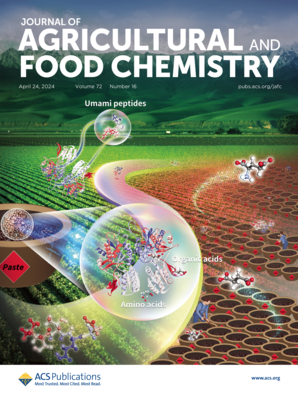Amelioration of Type 2 Diabetes Mellitus Using Rapeseed (Brassica napus)-Derived Peptides through Stimulating Calcium-Sensing Receptor: Effects on Glucagon-Like Peptide-1 Secretion and Hepatic Lipid Metabolism
IF 5.7
1区 农林科学
Q1 AGRICULTURE, MULTIDISCIPLINARY
引用次数: 0
Abstract
The potential of rapeseed-derived peptides (RDPs) in the amelioration of type 2 diabetes mellitus (T2DM) has been hypothesized. However, the mechanisms of the intestinal endocrine hormones activated by RDPs have not been fully understood. This study aimed to explore the amelioration of T2DM and associated hepatic lipid metabolism disorders using RDPs by affecting glucagon-like peptide-1 (GLP-1) secretion. Eight RDPs were prepared by different stepwise enzymatic hydrolysis, wherein RCPP-3 (sequential using alcalase/flavourzyme) and RNPP-1 (sequential using alcalase/trypsin) maintained the normal blood glucose level, significantly increased the body weight (27.17 ± 0.19%) in T2DM mice compared to the positive group (p < 0.05). Western blotting and immunofluorescence experiments indicated that RCPP-3 and RNPP-1 regulated the intestinal endocrine hormones GLP-1 secretion through the calcium-sensing receptor (CaSR). Additionally, the PI3K-Akt pathway was significantly activated by GLP-1, leading to marked improvements in hepatic lipid parameters (TC, TG, LDL-c, and HDL-c) and mitigated fat accumulation (p < 0.05). Notably, the stimulating effect of RCPP-3 on GLP-1 was 10.05% ± 0.71% higher than RNPP-1. G2-R3, a fraction separated from RCPP-3, which contained 14 peptides with the best capacity to stimulate GLP-1 secretion, was identified using HPLC-QTOF-MS/MS. This study suggests the potential of RDPs as novel functional food supplements for ameliorating T2DM.

利用油菜籽(甘蓝)衍生肽通过刺激钙感受体改善 2 型糖尿病:对胰高血糖素样肽-1分泌和肝脂代谢的影响
油菜籽衍生肽(RDPs)在改善 2 型糖尿病(T2DM)方面的潜力已被提出。然而,RDPs 激活肠道内分泌激素的机制尚未完全明了。本研究旨在探讨利用 RDPs 通过影响胰高血糖素样肽-1(GLP-1)的分泌来改善 T2DM 及相关的肝脂代谢紊乱。通过不同步骤的酶水解制备了八种 RDPs,其中 RCPP-3(依次使用乙醛酸酶/黄酶)和 RNPP-1(依次使用乙醛酸酶/胰蛋白酶)可维持正常血糖水平,与阳性组相比,可显著增加 T2DM 小鼠体重(27.17 ± 0.19%)(p < 0.05)。Western 印迹和免疫荧光实验表明,RCPP-3 和 RNPP-1 通过钙传感受体(CaSR)调节肠道内分泌激素 GLP-1 的分泌。此外,PI3K-Akt通路被GLP-1显著激活,导致肝脏血脂参数(TC、TG、LDL-c和HDL-c)明显改善,并减轻脂肪堆积(p <0.05)。值得注意的是,RCPP-3 对 GLP-1 的刺激作用比 RNPP-1 高 10.05% ± 0.71%。利用 HPLC-QTOF-MS/MS 方法鉴定了从 RCPP-3 中分离出来的 G2-R3 部分,其中含有 14 种刺激 GLP-1 分泌能力最强的肽。这项研究表明,RDPs 具有作为新型功能性食品补充剂改善 T2DM 的潜力。
本文章由计算机程序翻译,如有差异,请以英文原文为准。
求助全文
约1分钟内获得全文
求助全文
来源期刊
CiteScore
9.90
自引率
8.20%
发文量
1375
审稿时长
2.3 months
期刊介绍:
The Journal of Agricultural and Food Chemistry publishes high-quality, cutting edge original research representing complete studies and research advances dealing with the chemistry and biochemistry of agriculture and food. The Journal also encourages papers with chemistry and/or biochemistry as a major component combined with biological/sensory/nutritional/toxicological evaluation related to agriculture and/or food.

 求助内容:
求助内容: 应助结果提醒方式:
应助结果提醒方式:


